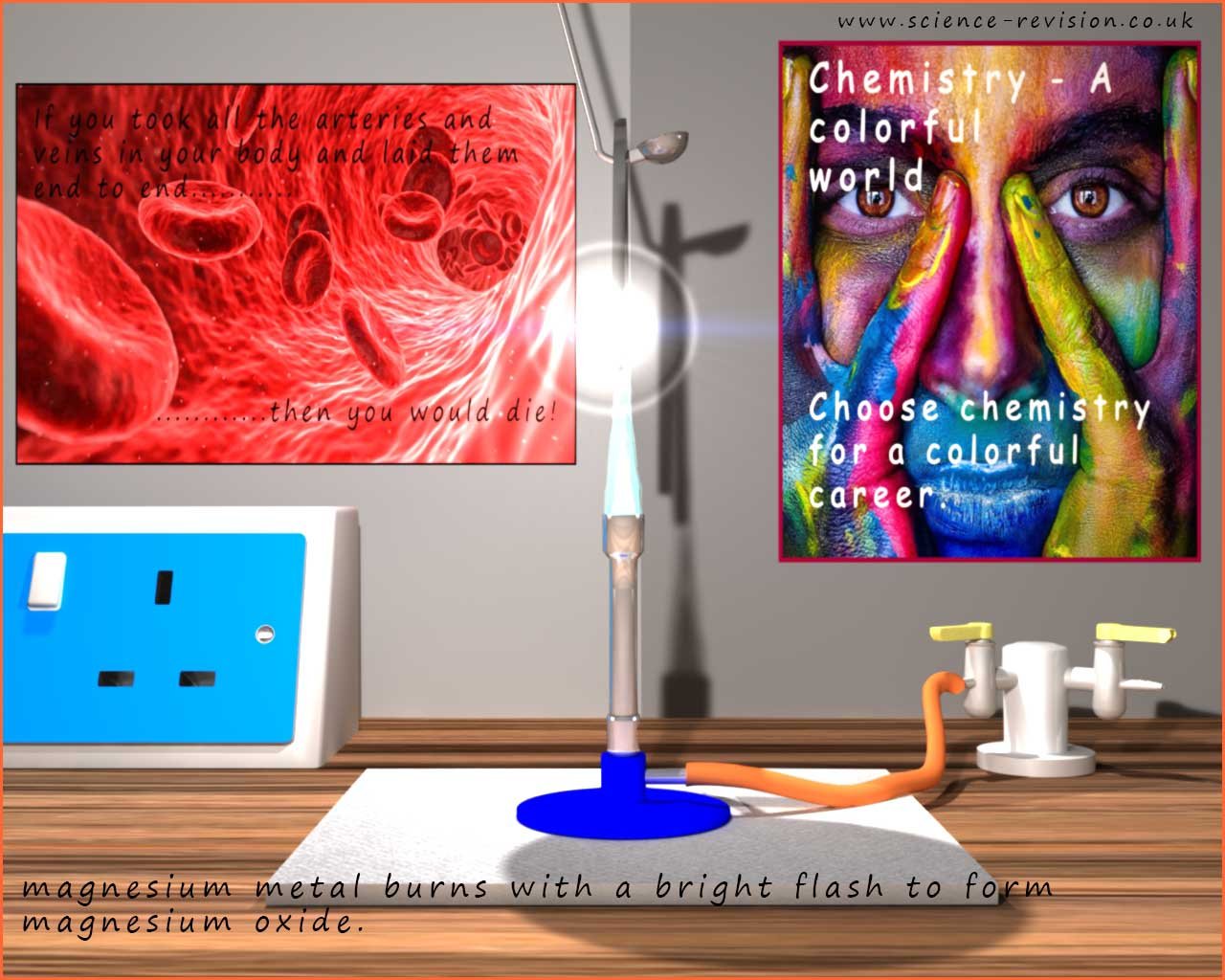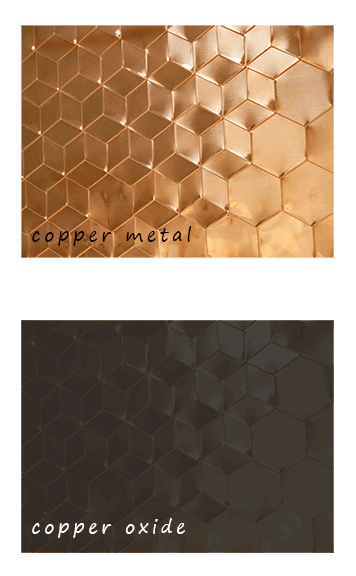Higher and foundation tiers
Metal oxides
Metals react with oxygen to produce metal oxides.
metal(s) + oxygen(g) → metal oxide(s)
No doubt at some time in your science lessons you will have held a piece of magnesium ribbon in a Bunsen flame and
cautiously observed the bright flash from the burning magnesium. However not all metal oxygen reactions are
as violent this.

Burning copper metal
 If a square of copper metal is held with a pair of tongs in a
hot Bunsen flame for about 30 seconds the shiny
bronze coloured copper turns black. No flames or bright flashes are produced. The copper
metal is reacting
with the oxygen in the air; it is being oxidised. An equation for this reaction is:
If a square of copper metal is held with a pair of tongs in a
hot Bunsen flame for about 30 seconds the shiny
bronze coloured copper turns black. No flames or bright flashes are produced. The copper
metal is reacting
with the oxygen in the air; it is being oxidised. An equation for this reaction is:
copper(s) + oxygen(g) → copper oxide(s)
In both the examples above the metals join with oxygen from the air and turn into a metal oxide.
The metal is oxidised. These metal reactions with oxygen are called
oxidation reaction.
Oxidation simply means adding oxygen to a substance.
The reactivity series
| potassium |
| sodium |
| lithium |
| calcium |
| magnesium |
| aluminium |
| carbon |
| zinc |
| iron |
| tin |
| lead |
| hydrogen |
| copper |
| silver |
| gold |
| platinum |
By observing how violent and fast the reactions of metals are when they are burned, react with water or react with
acids it is possible to rank the metals in order of reactivity.
The reactivity series is simply a list with the most reactive
metal at the top and the least reactive metal at the bottom. An outline of the reactivity series is shown opposite.
Reaction of metals with water- oxidation and reduction
Metals react with water to produce a metal hydroxide solution and hydrogen gas. We can show this as:
metal(s) + water(l) → metal hydroxide(aq) + hydrogen(g)
As an example consider the reactions of the alkali metal lithium with water:
:
lithium(s) + water(l) → lithium hydroxide(aq) + hydrogen(g)
2Li(s) + 2H2O(l) → 2LiOH(aq) + H2(g)
 The alkali metals and the metals radium, barium, strontium and calcium from group 2 of the periodic table
(the alkaline earth metals) all react
violently with water. However even a fairly reactive metal like magnesium reacts very slowly with water and it
would take days to collect enough hydrogen for a pop test! Remember the trends in the reactivity of
metals; the
metals become more reactive as you descend a group in the periodic table. The reason for this is because the
metals lose their outer
electrons more readily as you descend the group and so their reactivity increases.
The alkali metals and the metals radium, barium, strontium and calcium from group 2 of the periodic table
(the alkaline earth metals) all react
violently with water. However even a fairly reactive metal like magnesium reacts very slowly with water and it
would take days to collect enough hydrogen for a pop test! Remember the trends in the reactivity of
metals; the
metals become more reactive as you descend a group in the periodic table. The reason for this is because the
metals lose their outer
electrons more readily as you descend the group and so their reactivity increases.
When the metals react with water or oxygen they are losing their valence or outer shell electrons to form positively charged ions called cations e.g.
Metal - e → metal+
In the case of lithium reacting with water we have:
Li(s) - e → Li+(aq)
The lithium hydroxide formed is an ionic compound with positively charged lithium ions and negatively charged hydroxide ions (OH-(aq)).
Metals when they react lose electrons to form positively charged ions. We defined
oxidation earlier as the addition
of oxygen to a substance however we can extend this definition to include the loss of one or more electrons. Non-metals unlike metals gain electrons from the
metal when they react to form a negatively charged ion. The gain
of electrons is often called reduction e.g.
copper(s) + oxygen(g) → copper oxide(s) -word equation
2Cu(s) + 02(g) → 2CuO(s) - symbolic equation
2Cu(s) + 02(g) → 2Cu2+O2-(s) - ionic equation
In the ionic equation, we can clearly see that the copper atoms lose 2 electrons to form copper ions with a
2+ charge while the oxygen atoms gain 2e and form oxide ions with a 2- charge. The copper
is oxidised and the
oxygen is reduced. Reactions where one substance is reduced and another is oxidised are called
redox reactions.
Key Points
- Oxidation can be thought of as adding oxygen or removing electrons from a substance.
- Metals are oxidised when they react with non-metals. This means they lose electrons and form positively charged ions.
- Some metals will react with water to form alkaline solutions; that is a solution of a metal hydroxide. The gas hydrogen is also released.
- Reduction is the gain of electrons or the removal of oxygen from a substance.
Practice questions
Next



 If a square of copper metal is held with a pair of tongs in a
hot Bunsen flame for about 30 seconds the shiny
bronze coloured copper turns black. No flames or bright flashes are produced. The copper
metal is reacting
with the oxygen in the air; it is being oxidised. An equation for this reaction is:
If a square of copper metal is held with a pair of tongs in a
hot Bunsen flame for about 30 seconds the shiny
bronze coloured copper turns black. No flames or bright flashes are produced. The copper
metal is reacting
with the oxygen in the air; it is being oxidised. An equation for this reaction is:
 The alkali metals and the metals radium, barium, strontium and calcium from group 2 of the periodic table
(the alkaline earth metals) all react
violently with water. However even a fairly reactive metal like magnesium reacts very slowly with water and it
would take days to collect enough hydrogen for a pop test! Remember the trends in the reactivity of
metals; the
metals become more reactive as you descend a group in the periodic table. The reason for this is because the
metals lose their outer
electrons more readily as you descend the group and so their reactivity increases.
The alkali metals and the metals radium, barium, strontium and calcium from group 2 of the periodic table
(the alkaline earth metals) all react
violently with water. However even a fairly reactive metal like magnesium reacts very slowly with water and it
would take days to collect enough hydrogen for a pop test! Remember the trends in the reactivity of
metals; the
metals become more reactive as you descend a group in the periodic table. The reason for this is because the
metals lose their outer
electrons more readily as you descend the group and so their reactivity increases.